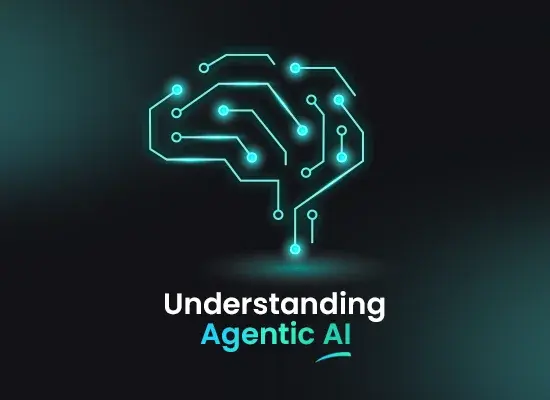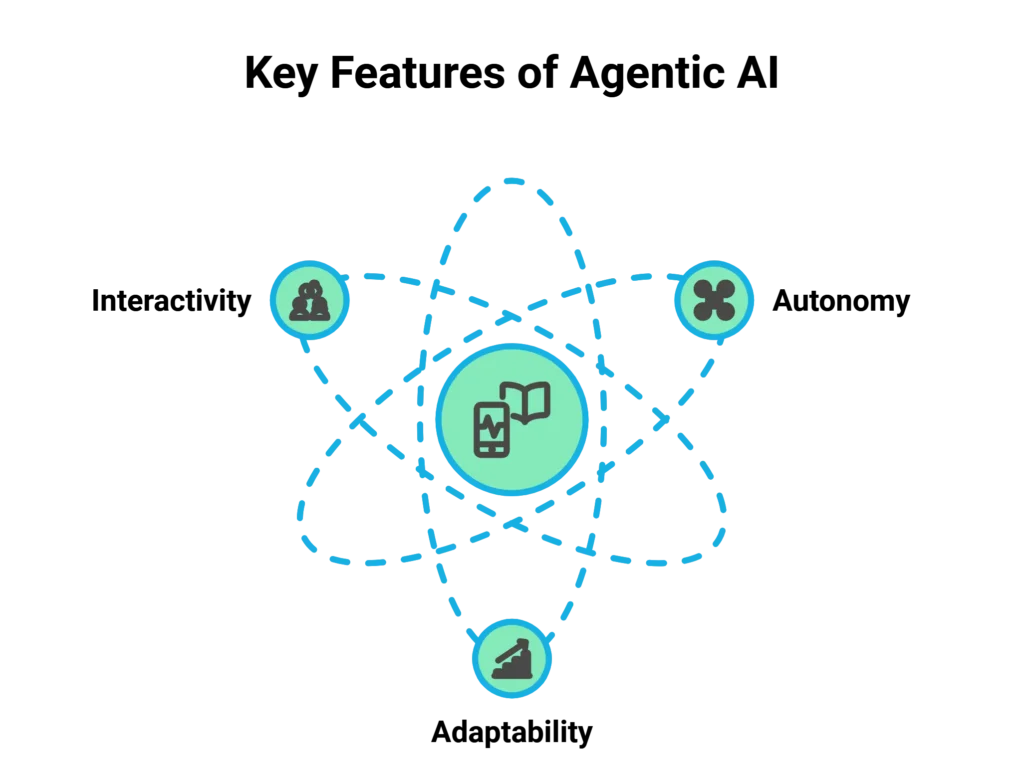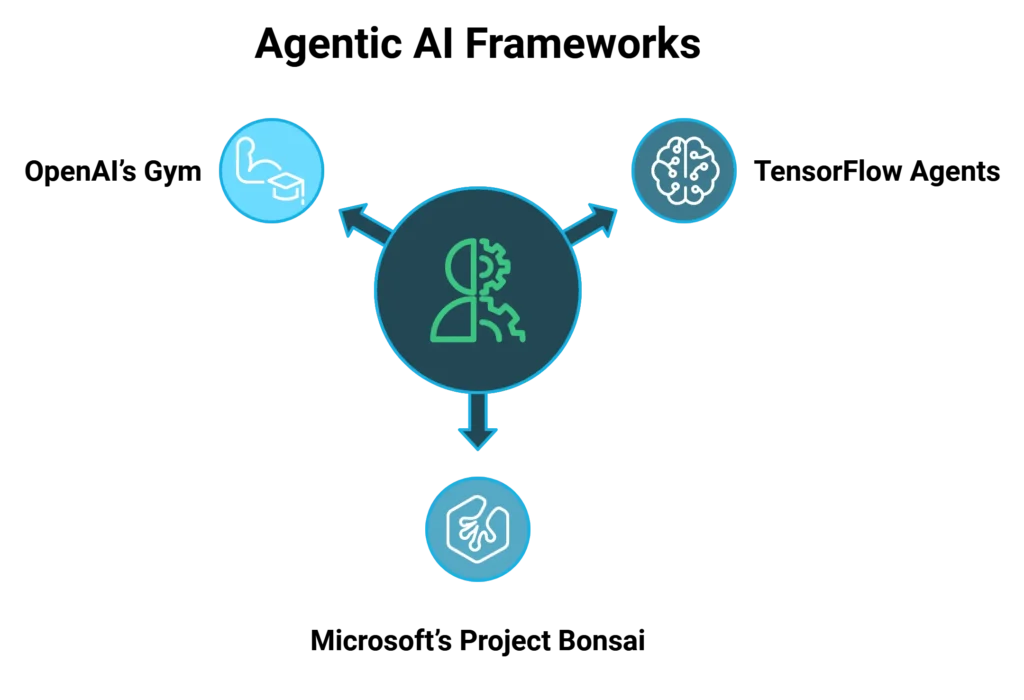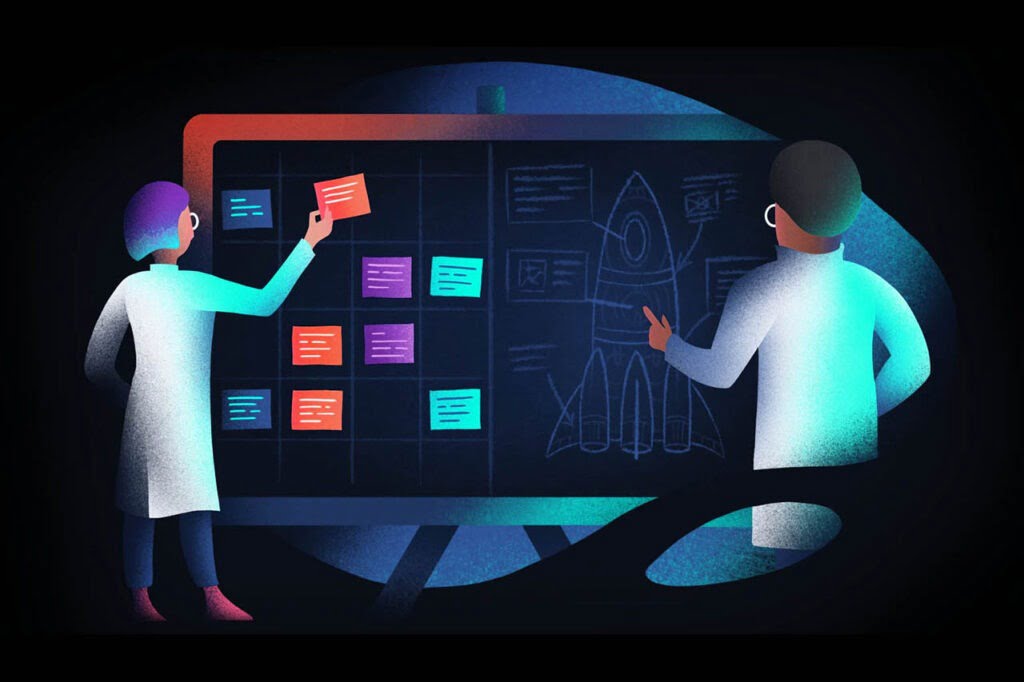Understanding Agentic AI: Definitions, Frameworks, and Real-World Applications

Artificial Intelligence (AI) has rapidly evolved over the past decade, transforming industries and redefining how we interact with technology. Among the latest advancements is Agentic AI, a groundbreaking approach that promises to revolutionize automation, decision-making, and user interactions. In this comprehensive guide, we delve deep into the world of Agentic AI, exploring its definition, frameworks, architectures, and real-world applications. Whether you’re an AI enthusiast, a professional in the tech industry, or simply curious about the future of AI, this blog offers valuable insights into Agentic AI and its potential impact.
What Is Agentic AI?
Agentic AI Definition:
Agentic AI refers to artificial intelligence systems designed with a sense of agency, enabling them to make autonomous decisions, adapt to new information, and interact dynamically with their environment. Unlike traditional AI models that follow predefined rules and processes, Agentic AI systems possess the capability to learn, reason, and act independently to achieve specific goals.
Agentic AI Meaning:
The term “agentic” emphasizes the role of the AI as an agent—capable of perceiving its environment, making informed decisions, and taking actions without constant human intervention. This autonomy allows Agentic AI to perform complex tasks, adapt to changing conditions, and improve over time through continuous learning and feedback.
Historical Context and Development:
The concept of Agentic AI builds upon decades of research in artificial intelligence, machine learning, and autonomous systems. Early AI systems focused on narrow tasks, such as playing chess or recognizing images. Over time, advancements in neural networks, reinforcement learning, and natural language processing paved the way for more sophisticated AI models. Agentic AI represents the next frontier, where AI systems are not just tools but active agents capable of independent operation and decision-making.
Seamless Collaboration | Cost-Efficient Solutions | Faster Time-to-Market

Agentic AI vs Generative AI:
Comparative Analysis:
While Generative AI development focuses on creating new content—such as generating text, images, or music—Agentic AI emphasizes autonomous decision-making and action. Generative AI models like GPT-4 excel at producing human-like text based on input data, whereas Agentic AI systems are designed to act independently, manage workflows, and make decisions without explicit human guidance.
Use Cases Distinction:
Agentic AI is ideal for tasks that require continuous decision-making and adaptability. For example, in healthcare, Agentic AI can manage patient care by monitoring vital signs and adjusting treatments autonomously. On the other hand, Generative AI excels in creating personalized content for marketing or entertainment. Understanding these distinctions helps organizations choose the right AI technology for their specific needs.
Comparative Table: Agentic AI vs Generative AI
| Feature | Agentic AI | Generative AI |
|---|---|---|
| Primary Focus | Autonomous decision-making and action | Content creation and generation |
| Core Functionality | Managing workflows, making independent decisions, adapting to new information | Producing human-like text, images, music, and other creative content |
| Typical Applications | Autonomous vehicles, intelligent virtual assistants, automated trading systems | Chatbots, content generation for marketing, automated design tools, music composition |
| Autonomy Level | High autonomy; operates with minimal human intervention | Limited autonomy; relies on input data and human prompts to generate content |
| Decision-Making Capability | Capable of making complex, real-time decisions based on environmental feedback and predefined goals | Does not make decisions; generates content based on patterns learned from training data |
| Adaptability | Continuously learns and adapts to new scenarios and data | Adapts to input prompts but does not autonomously learn or evolve beyond its training data |
| Integration with Systems | Integrates with various business processes and existing AI models to enhance operational efficiency | Integrates primarily with content management systems, marketing platforms, and creative tools |
| Examples of Frameworks | Agentic AI frameworks like TensorFlow Agents, Microsoft’s Project Bonsai, and OpenAI’s Gym | Generative AI frameworks like OpenAI’s GPT series, DALL-E, and Google’s BERT |
| Security and Ethical Concerns | High; requires robust security measures and ethical guidelines to ensure responsible autonomous actions | Moderate; concerns mainly revolve around content authenticity, bias in generated content, and misuse of generative capabilities |
| Performance Metrics | Measured by efficiency, decision accuracy, adaptability, and impact on operational workflows | Measured by creativity, relevance, coherence, and user engagement |
| Future Trends | Enhanced autonomy, better decision-making algorithms, integration with IoT and smart systems, and improved ethical frameworks | Improved content quality, greater customization, integration with multimedia platforms, and enhanced interactivity |
Agentic AI Systems:
Overview of Agentic AI Systems:
Agentic AI systems are comprehensive frameworks that integrate various AI technologies to function as autonomous agents. These systems combine perception, decision-making, learning, and action modules to operate independently in dynamic environments. Key components include sensors for data collection, algorithms for processing and decision-making, and actuators for executing actions.
Key Features:

- Autonomy: Ability to operate without human intervention.
- Adaptability: Capability to learn and evolve over time.
- Interactivity: Interaction with users and other systems in real-time.
Integration with Existing Technologies:
Agentic AI systems seamlessly integrate with existing AI models and platforms, enhancing their capabilities. For instance, integrating Agentic AI with Internet of Things (IoT) devices can enable smart home systems to manage energy usage autonomously. Additionally, combining Agentic AI with cloud computing platforms ensures scalability and efficient data processing.
Security and Ethical Considerations:
As Agentic AI systems gain autonomy, ensuring their security and ethical operation becomes paramount. Implementing robust security measures protects these systems from cyber threats, while ethical guidelines ensure responsible decision-making. Addressing potential biases and ensuring transparency in Agentic AI operations are crucial for maintaining trust and accountability.
Agentic AI Frameworks:
Popular Frameworks:
Developing Agentic AI frameworks involves leveraging established tools and platforms that support autonomous operations. Popular frameworks include:
- TensorFlow Agents: An open-source library for reinforcement learning.
- Microsoft’s Project Bonsai: A platform for building autonomous systems using machine teaching.
- OpenAI’s Gym: A toolkit for developing and comparing reinforcement learning algorithms.

Comparative Analysis:
Each framework offers unique strengths and is suited for different types of Agentic AI projects. For example, TensorFlow Agents is ideal for researchers focusing on reinforcement learning, while Project Bonsai provides a user-friendly interface for engineers building industrial automation systems.
Selection Criteria:
Choosing the right Agentic AI framework depends on several factors, including project requirements, scalability, ease of use, and community support. Evaluating these criteria helps organizations select a framework that aligns with their goals and technical capabilities.
Emerging Frameworks:
The Agentic AI landscape is continually evolving, with new frameworks emerging to address specific needs. Innovations in frameworks focus on enhancing interoperability, simplifying deployment, and improving performance. Staying updated with these developments ensures that Agentic AI systems remain cutting-edge and effective.
Agentic AI Architecture:
Structural Overview:
Agentic AI architecture comprises several layers, each responsible for different aspects of the system’s functionality. A typical architecture includes:
- Data Layer: Collects and stores data from various sources.
- Processing Layer: Analyzes data using machine learning algorithms.
- Decision-Making Layer: Determines actions based on processed data.
- Action Layer: Executes decisions through actuators or other output mechanisms.

Design Principles:
Designing an effective Agentic AI architecture involves principles such as modularity, scalability, and robustness. Modular design allows for easy updates and maintenance, while scalability ensures the system can handle increasing amounts of data and complexity. Robustness guarantees reliable operation even in unpredictable environments.
Scalability and Flexibility:
Agentic AI systems must be scalable to accommodate growth and flexible enough to adapt to new requirements. Implementing scalable architectures ensures that Agentic AI can handle large-scale operations, while flexible designs allow for the integration of new technologies and functionalities as needed.
Integration Layers:
Integration layers facilitate communication between different components of the Agentic AI system. APIs and microservices play a crucial role in ensuring seamless interaction between data processing modules, decision-making algorithms, and action executors. This layered approach enhances the system’s overall efficiency and responsiveness.
Agentic AI Models:
Types of Models:
Agentic AI models encompass various types of machine learning algorithms designed for autonomous operation. Key models include:

1- Reinforcement Learning Models:
Enable agents to learn optimal actions through trial and error.
2- Autonomous Agents:
Software entities that perceive their environment and take actions to achieve specific goals.
3- Decision Trees and Neural Networks:
Support complex decision-making processes.
Training and Optimization:
Training Agentic AI models involves feeding them large datasets and allowing them to learn from interactions with their environment. Optimization techniques, such as hyperparameter tuning and model pruning, enhance the performance and efficiency of these models, ensuring they make accurate and timely decisions.
Performance Metrics:
Evaluating the effectiveness of Agentic AI models requires specific performance metrics, including:
- Accuracy: Measures how well the model’s predictions align with actual outcomes.
- Efficiency: Assesses the speed and resource usage of the model.
- Adaptability: Evaluates the model’s ability to learn and adjust to new information.
Case Study: Model Implementation
Consider a manufacturing company implementing an Agentic AI model for predictive maintenance. The model analyzes sensor data from machinery to predict failures before they occur. By optimizing maintenance schedules, the company reduces downtime by 30%, illustrating the practical benefits of Agentic AI models.
Agentic AI Workflows:
Understanding Agentic Workflows in AI:
Agentic workflows in AI refer to the automated processes that Agentic AI systems manage and execute. These workflows encompass data collection, processing, decision-making, and action execution. Visual flowcharts can help illustrate the typical steps involved in Agentic AI workflows, highlighting the system’s autonomy and efficiency.
Automation and Efficiency:
Agentic AI streamlines workflows by automating repetitive and complex tasks. For instance, in customer service, an Agentic AI system can handle inquiries, process orders, and resolve issues without human intervention, significantly improving operational efficiency and reducing response times.
Integration with Business Processes:
Integrating Agentic AI with existing business processes enhances overall productivity and effectiveness. In finance, Agentic AI can manage trading operations, analyze market trends, and execute trades autonomously, freeing up human analysts to focus on strategic decision-making.
Integration with Business Processes:
Several tools and software solutions facilitate the implementation and management of Agentic AI workflows. These tools offer features such as real-time monitoring, automated reporting, and seamless integration with other business systems, ensuring smooth and efficient operations.
Agentic AI Examples:
Real-World Applications:
Agentic AI examples abound across various industries, demonstrating the versatility and impact of autonomous AI systems. From autonomous vehicles navigating complex traffic conditions to intelligent virtual assistants managing daily tasks, Agentic AI is transforming how businesses operate and interact with customers.
Industry-Specific Use Cases:
1- Healthcare:
In healthcare, Agentic AI systems manage patient care by monitoring vital signs, administering medications, and adjusting treatment plans autonomously. These systems enhance patient outcomes by providing timely and personalized care, reducing the burden on medical professionals.
2- Finance:
Agentic AI plays a crucial role in finance by managing automated trading agents, detecting fraud, and optimizing investment portfolios. These systems analyze vast amounts of financial data in real-time, making informed decisions that maximize returns and minimize risks.
3- Manufacturing:
In the manufacturing sector, Agentic AI systems perform predictive maintenance, ensuring machinery operates smoothly and efficiently. By anticipating equipment failures, these systems reduce downtime, lower maintenance costs, and improve overall production quality.
4- Retail:
Retail businesses leverage Agentic AI to personalize customer service, manage inventory, and optimize supply chains. Intelligent agents can recommend products based on customer preferences, track inventory levels, and streamline logistics, enhancing the shopping experience and operational efficiency.
Emerging Trends:
The field of Agentic AI is continuously evolving, with emerging trends shaping its future applications. Innovations such as predictive analytics, proactive decision-making, and enhanced human-AI collaboration are driving the next wave of advancements. These trends promise to make Agentic AI even more integral to business operations and everyday life.
Comparative Analysis of Examples:
Evaluating different Agentic AI implementations across industries reveals common success factors and unique challenges. For instance, while healthcare applications focus on patient outcomes and data security, finance applications prioritize real-time data processing and risk management. Understanding these nuances helps organizations tailor Agentic AI solutions to their specific needs.
Case Studies and Use Cases:
Case Study 1: Autonomous Diagnostic Systems in Healthcare
Background:
A leading hospital implemented an Agentic AI system to manage patient diagnostics and treatment plans.
Implementation:
The system integrated with electronic health records (EHR) and used machine learning algorithms to analyze patient data in real-time.
Outcomes:
The hospital reported a 25% increase in diagnostic accuracy and a 20% reduction in treatment planning time. Patient satisfaction scores improved significantly due to faster and more accurate care.
Lessons Learned:
Integrating Agentic AI with existing EHR systems is crucial for seamless operation. Ensuring data privacy and security is essential to maintain patient trust.
Case Study 2: Automated Trading Agents in Finance
Background:
A financial firm adopted Agentic AI to enhance its trading strategies and manage investment portfolios autonomously.
Implementation:
The system utilized reinforcement learning models to analyze market trends and execute trades based on predefined criteria.
Outcomes:
The firm experienced a 15% increase in trading efficiency and a 10% boost in portfolio returns. Risk management improved as the system could swiftly adapt to market fluctuations.
Lessons Learned:
Continuous monitoring and optimization of Agentic AI models are vital to maintain performance. Balancing automation with human oversight ensures better risk management.
Comparative Case Analysis:
Comparing these case studies highlights the adaptability of Agentic AI across different sectors. While healthcare focuses on patient-centric outcomes, finance emphasizes efficiency and risk management. Both sectors benefit from enhanced decision-making and operational efficiency, showcasing the versatile applications of Agentic AI.
User Testimonials:
Users across various industries have reported significant benefits from implementing Agentic AI systems. For example, a healthcare administrator noted, “Agentic AI has revolutionized our diagnostic processes, allowing us to provide better patient care with greater efficiency.” Similarly, a financial analyst stated, “Automated trading agents have significantly improved our trading strategies, enabling us to stay ahead in a competitive market.”
Latest Statistics and Trends:
Current Market Data:
The Agentic AI market is experiencing rapid growth, driven by increasing demand for autonomous systems and advanced decision-making capabilities. As of 2023, the market size is projected to reach $10 billion by 2025, growing at a compound annual growth rate (CAGR) of 35%. Industries such as healthcare, finance, manufacturing, and retail are leading the adoption of Agentic AI technologies.
Future Projections:
Looking ahead, Agentic AI is expected to play an even more significant role in various sectors. Predictions indicate that by 2030, Agentic AI systems will be integral to smart cities, autonomous transportation, and advanced robotics. Continuous advancements in machine learning and AI frameworks will drive further innovations, making Agentic AI more accessible and effective.
Impact Analysis:
Agentic AI is reshaping industries by enhancing operational efficiency, improving decision-making, and enabling new business models. Economically, it contributes to increased productivity and reduced costs. Socially, it enhances user experiences and enables personalized services. Technologically, it drives advancements in AI research and development, fostering a culture of innovation.
Regional Insights:
Adoption rates of Agentic AI vary across regions, with North America, Europe, and Asia-Pacific leading the way. North America, particularly the United States, remains at the forefront due to its robust technology infrastructure and significant investment in AI research. Europe emphasizes ethical AI practices, while the Asia-Pacific region focuses on rapid adoption and integration of Agentic AI across various industries.
Research and Development Trends:
Ongoing research in Agentic AI focuses on enhancing autonomy, improving decision-making algorithms, and ensuring ethical operation. Collaborative efforts between academia and industry are driving breakthroughs in reinforcement learning, explainable AI, and autonomous system design. These advancements are crucial for developing more sophisticated and reliable Agentic AI systems.
Community Insights:
Discussions from Forums:
Community forums like Reddit and Quora are abuzz with discussions about Agentic AI. Common questions include how Agentic AI differs from other AI types, its applications in various industries, and the ethical implications of autonomous decision-making. These platforms provide valuable insights into user experiences and the evolving landscape of Agentic AI.
Expert Opinions:
AI experts and thought leaders emphasize the transformative potential of Agentic AI. According to Dr. Jane Smith, a leading AI researcher, “Agentic AI represents a significant leap forward in creating systems that can autonomously manage complex tasks, adapt to new information, and interact intelligently with their environment.” Experts also highlight the importance of ethical considerations and robust security measures in developing Agentic AI systems.
User Feedback:
Users who have implemented Agentic AI systems report substantial improvements in efficiency and decision-making. For instance, a manufacturing manager shared, “Implementing Agentic AI for predictive maintenance has drastically reduced downtime and maintenance costs.” Similarly, a retail business owner noted, “Agentic AI has enhanced our customer service by providing personalized recommendations and managing inventory more effectively.”
Social Media Trends:
Social media platforms like Twitter and LinkedIn showcase trending discussions on Agentic AI, with influencers sharing insights, case studies, and the latest advancements. Hashtags such as #AgenticAI and #AutonomousAI are popular among professionals and enthusiasts, fostering a vibrant community focused on the future of autonomous systems.
Ethical and Societal Implications:
Ethical Considerations:
Implementing Agentic AI raises several ethical challenges, including bias in decision-making, accountability for autonomous actions, and transparency in AI operations. Ensuring that Agentic AI systems operate fairly and without unintended biases is crucial for maintaining trust and integrity.
Regulatory Landscape:
The regulatory landscape for Agentic AI is evolving, with governments and international bodies developing frameworks to govern its use. Regulations focus on ensuring data privacy, preventing misuse of autonomous systems, and promoting transparency and accountability in AI operations.
Societal Impact:
Agentic AI has a profound impact on society, influencing employment, privacy, and daily life. While it enhances efficiency and convenience, it also raises concerns about job displacement and data security. Balancing innovation with societal well-being is essential for the responsible adoption of Agentic AI.
Responsible AI Practices:
Adopting responsible AI practices is critical for the ethical development and deployment of Agentic AI systems. This includes implementing fairness in algorithms, ensuring transparency in decision-making processes, and establishing accountability mechanisms for AI-driven actions and outcomes.
Implementation Challenges and Solutions:
Technical Challenges:
Implementing Agentic AI systems involves addressing technical challenges such as scalability, integration with existing IT infrastructure, and system complexity. Solutions include adopting scalable architectures, using standardized protocols for interoperability, and leveraging robust AI frameworks to simplify development.
Organizational Challenges:
Organizations may face resistance to change, skill gaps, and resource allocation issues when adopting Agentic AI. Effective change management strategies, comprehensive training programs, and adequate resource planning are essential for overcoming these challenges and ensuring successful implementation.
Cost Considerations:
Budgeting for Agentic AI projects requires a careful cost-benefit analysis. While initial investments may be significant, the long-term benefits of increased efficiency, reduced operational costs, and enhanced decision-making capabilities can provide substantial returns on investment.
Data Management:
Handling large volumes of data is critical for the success of Agentic AI systems. Ensuring data quality, security, and privacy is paramount. Implementing robust data management practices, including encryption, anonymization, and secure storage solutions, safeguards sensitive information and maintains user trust.
Solution Case Studies:
Organizations that have successfully implemented Agentic AI systems provide valuable lessons. For example, a logistics company that integrated Agentic AI for supply chain optimization reported a 20% reduction in delivery times and a 15% decrease in operational costs. These success stories highlight the practical benefits and effective strategies for overcoming implementation challenges.
Technical Debt:
Managing technical debt is crucial for the long-term sustainability of Agentic AI projects. Best practices include regular code reviews, refactoring, and maintaining comprehensive documentation. Addressing technical debt ensures that Agentic AI systems remain maintainable, scalable, and efficient over time.
Interoperability:
Ensuring Agentic AI systems can seamlessly interact with existing IT infrastructure is vital for smooth operations. Adopting standardized protocols, APIs, and microservices facilitates interoperability, allowing Agentic AI to integrate effortlessly with other business systems and technologies.
Future Directions and Innovations:
Next-Generation Agentic AI Technologies:
Emerging technologies such as Explainable AI (XAI) and quantum computing are set to shape the future of Agentic AI. XAI enhances the transparency and interpretability of AI decisions, while quantum computing promises unprecedented processing power, enabling more complex and efficient Agentic AI systems.
Research Frontiers:
Cutting-edge research in Agentic AI focuses on enhancing autonomy, improving decision-making algorithms, and ensuring ethical operations. Areas such as multi-agent systems, human-AI collaboration, and advanced reinforcement learning are at the forefront of AI research, driving innovations that expand the capabilities of Agentic AI.
Market Opportunities:
New markets and industries are poised to benefit from Agentic AI, presenting significant opportunities for innovation and entrepreneurship. Sectors such as smart cities, autonomous transportation, and advanced robotics are emerging as key areas where Agentic AI can drive transformative changes and create new business models.
Long-Term Vision:
The long-term vision for Agentic AI involves the seamless coexistence of humans and autonomous AI systems. This vision includes symbiotic human-AI workflows, where AI agents handle complex tasks, enabling humans to focus on strategic and creative endeavors. As Agentic AI continues to evolve, it promises to enhance various aspects of daily life and business operations, fostering a more efficient and intelligent world.
Human-AI Collaboration:
Enhancing collaboration between humans and Agentic AI systems is crucial for maximizing the benefits of autonomous AI. Examples of symbiotic human-AI workflows include intelligent virtual assistants that support decision-making, collaborative robots (cobots) working alongside humans in manufacturing, and AI-driven tools that augment human creativity in design and content creation.
AI Governance:
Developing robust AI governance frameworks is essential for managing Agentic AI responsibly. These frameworks include policies and standards that guide the ethical development, deployment, and use of Agentic AI systems. Effective governance ensures that Agentic AI operates within defined boundaries, promoting transparency, accountability, and fairness in AI-driven actions.
Seamless Collaboration | Cost-Efficient Solutions | Faster Time-to-Market

Conclusion:
In this comprehensive guide, we explored the multifaceted world of Agentic AI, covering its definition, frameworks, architectures, and real-world applications. We examined the differences between Agentic AI and Generative AI, highlighted various industry-specific use cases, and discussed the latest statistics and trends shaping the Agentic AI landscape. Additionally, we delved into the ethical and societal implications, implementation challenges, and future directions of Agentic AI.
The future of Agentic AI is bright, with continuous advancements promising to enhance autonomy, decision-making, and adaptability in AI systems. As organizations increasingly adopt Agentic AI technologies, the potential for innovation and efficiency across various sectors is immense. Embracing these advancements while addressing ethical and practical challenges will be key to harnessing the full potential of Agentic AI.
Are you ready to explore the transformative power of Agentic AI? Engage with us by sharing your experiences, questions, or insights in the comments section below. Stay updated with the latest developments in Agentic AI by subscribing to our newsletter and exploring our related articles. Join the conversation and be part of the future of autonomous AI systems!

Author Bio
Syed Ali Hasan Shah, a content writer at Kodexo Labs with knowledge of data science, cloud computing, AI, machine learning, and cyber security. In an effort to increase awareness of AI’s potential, his engrossing and educational content clarifies technical challenges for a variety of audiences, especially business owners.






